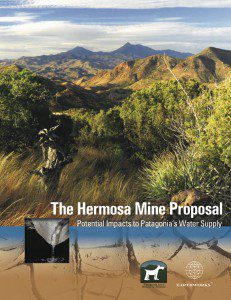Hermosa Mine Proposal: Potential Impacts to Patagonia’s Water Supply
Executive SummaryHome // Who We Are // Our Concerns //
 The 4,000-foot wide and 1,500-foot deep open-pit silver and manganese Hermosa mine proposed by AZ Mining Inc (Wildcat Silver) in southeastern Arizona, six miles from the town of Patagonia, threatens both the quantity and quality of area water supplies.
The 4,000-foot wide and 1,500-foot deep open-pit silver and manganese Hermosa mine proposed by AZ Mining Inc (Wildcat Silver) in southeastern Arizona, six miles from the town of Patagonia, threatens both the quantity and quality of area water supplies.
Using geologic and hydrologic studies from mine developer AZ Mining Inc (Wildcat Silver), the United States Geologic Survey, the Arizona Department of Water Resources, the town of Patagonia, and others, and by analyzing historic contamination issues caused by mining in the Patagonia Mountains, Hermosa Mine Proposal: Potential Impacts to Patagonia’s Water Supply explains how:
Patagonia is already facing a water supply crisis and new industrial water demands will make the problem worse.
- Private and municipal water well levels in Patagonia are dropping rapidly and some have already gone dry. Emergency measures are being considered.
- The groundwater the mine would pump for operations is within Patagonia’s municipal supply watershed. The mine’s consumption will lower recharge rates for the aquifer on which the town depends, potentially depleting it.
- As proposed, the mine would consume between 670 million and 1.2 billion gallons of water every year – 28 to 53 times more water than consumed by the entire town of Patagonia, and as much as 25,000 to 46,000 Arizonans.
- After the mine is closed, a lake containing billions of gallons of water will form in the abandoned mine pit, further increasing groundwater depletion in the adjacent aquifers as the lake forms. Evaporation from this pit lake will annually consume groundwater at a rate comparable to when the mine was in operation, yet it will occur forever.
The geology of the deposit virtually guarantees that the mine’s waste will cause acid drainage and metals leaching to contaminate water in perpetuity – an expensive and ever-lasting problem often paid for by taxpayers.
- Most mines in the Patagonia Mountains continue to leach acid today, despite the fact that operations ceased over 50 years ago. Many of the area’s seasonal creeks are locally contaminated, and so is the groundwater beneath them.
- Because the Hermosa Mine would move 1,679 times more rock than the largest of these past mines, its long term contamination legacy would be far more impactful than anything experienced in the past.
- Because previous studies have shown that groundwater flows down the drainage in which the mine is proposed, there is risk of contamination by acid, heavy metals and sulfate in water wells below the mine site, potentially as far as Patagonia.
- A large tailings impoundment holding toxic mine waste could catastrophically fail and dump millions of tons of contaminated sediment into the creek valley that leads to town. Three similar accidents have already occurred in North America in 2014 alone.
The proposal has numerous other impacts:
- It may consume as much electricity as over 35,000 Arizonans, burn 9.3 million gallons of diesel fuel each year, and emit 591 million pounds of carbon dioxide pollution annually – equivalent to 71,000 cars.
- Light and noise pollution would be a constant reality for the 18 years the mine is projected to operate.
- The widening of Forest Service roads and numerous other types of infrastructure development will affect existing recreational uses and residences near and beyond the mine site.
- Wildlife is likely to be negatively affected as area springs run dry to due groundwater depletion.
http://www.patagoniaalliance.org/wp-content/uploads/2014/11/Report-Hermosa-Mine-Proposal.pdf

